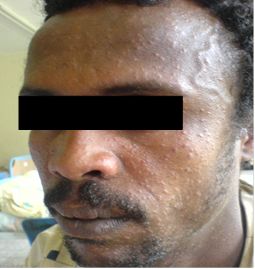Post Kala-azar Dermal Leishmaniasis (PKDL)
This is a painless maculo-papular and nodular rash that starts from the paranasal areas on the face and spreads all over the body. It occurs only with L donovani as etiology; not with L infantum. It is commonly seen in Sudan (in 50-60%) and occurs within six months of treatment. In India subcontinent, the incidence is 5-10% and occurs years later.
In Ethiopia it is more frequently seen among HIV co-infected patients. PKDL may also occur before the VL (Pre-KDL), together with the VL (para-KDL) or post treatment (PKDL). PKDL may be a sign of immune reconstitution. While the skin lesions are staffed with leishmania parasites, the parasites are typically absent from the spleen and bone marrow. Patients with PKDL may serve as reservoirs in the community and play role in the transmission of the disease.
The clinical severity is graded in to three:
Grade 1 – scattered maculopapular or nodular rash mainly on the face. Few areas in the upper chest and limbs may be involved.
Grade 2 – dense lesions extending from the face to the chest, back, upper arms and legs. Blackened or extensive lesions with mucosal involvement are classified as severe grade 2
Grade 3 – this is when the lesions are covering the whole body including the hands and feet. Lesions may form crust, ulcers, sloughing, scaling, blackening and involve mucosa (lips and palate).
Treatment of PKDL – Grade 1 and mild forms of grade 2 PKDL do not need treatment. Such extent of PKDL usually resolves with time spontaneously. Severe form of grade 2 and grade 3 PKDL need drug treatment. Antimonial injections are the recommended and well tolerated medicines recommended in the Ethiopian national guidelines. Combination of SSG and Paromomycin also showed good response rate in a study in Sudan. Miltefosine has good penetration into the skin and good response rate was observed in India. In general PKDL can be treated with any of the regimens as VL. Treatment has to be continued until the lesions get flatten, but scar may persist.
